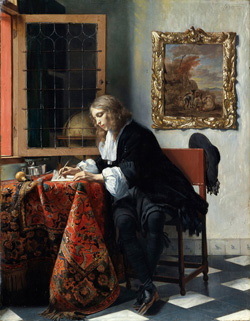Gabriel Metsu was a dog person. Sure, he was other things too—a prodigy, a technical master, a champion of capturing human emotion with a paintbrush, and, despite not even living to 40, one of the most prolific of the impressive band of seventeenth-century Dutch painters. But looking at the paintings in Gabriel Metsu, a new exhibition on display in the National Gallery of Art’s East Building, it’s clear that the artist really loved man’s best friend.
In a majority of the stunning, few-dozen paintings that comprise the exhibition, a brown and white dog—some kind of terrier, perhaps?—of varying size sand bodily positions pops up in the foreground of the scene. While this might seem a little random or unworthy of note, this ubiquitous canine is a microcosm of Metsu’s talent. Even when he’s only a few inches long, putting his front paws on the skirt of a light-bathed noblewoman in “A Hunter Visiting a Woman at Her Toilet” (note: not a toilet in the modern sense), this dog is exquisite—his long fur shines with dimension, his eyes light up with genuine animal emotion, and his loose-hanging silken ribbon looks real enough for the viewer to reach into the canvas and pull.

Gabriel Metsu is arranged chronologically, with each of the exhibit’s two rooms representing a single decade of his 20-year career of oil-on-canvas painting. The setup is intuitive and effective, showing the clear progression of the artist’s career. The first room, containing paintings from the 1650s, focuses more heavily on background and setting than on human subjects. “An Old Woman with Her Meal” takes place in a painstakingly detailed room, complete with a small, glimmering glass of orange liquid and a playful kitten at her feet. Even in his own self-portrait, “A Hunter Getting Dressed After Bathing,” Metsu focuses more on the background than on the human subject, and the lush, captivating scene behind the man—and, of course, a prominently-sized dog—almost make the viewer forget that the painting is of a very realistic, and not very attractive, nude Metsu.
The second room demonstrates a shift to a more person-centric style, as Metsu’s 1660s work demonstrates his ability to capture strikingly lifelike, detailed human emotion. The complementary side-by-side portraits “A Woman Reading a Letter” and “A Man Writing a Letter” embody the sadness of two parted lovers, and each contains a painting-within-a-painting that could be a work of art by itself. This room also showcases Metsu’s ability to paint draped, light-reflecting fabric, and a piece of embroidered red brocade pops up almost as frequently as the still-persistent puppy.
As an exhibit in the East Building of the National Gallery, which houses Calder’s mobiles and other marvels of modern art, a seventeenth-century oil painting exhibit like Gabriel Metsu might seem a little incongruous. But Metsu’s technical merit and delicate emotion make him worthy of display alongside visual artists from any era—plus, he paints some pretty damn adorable puppies.




